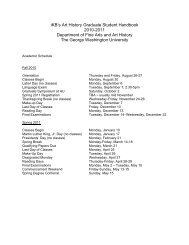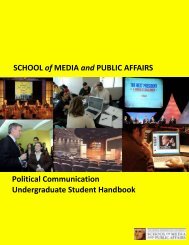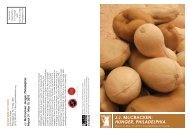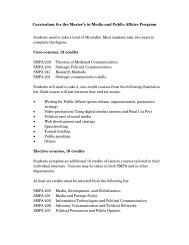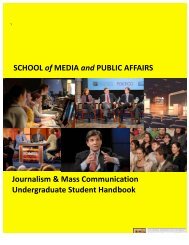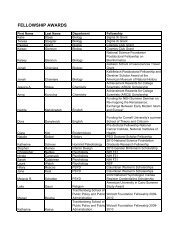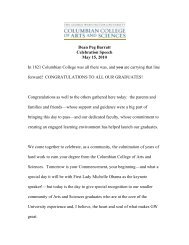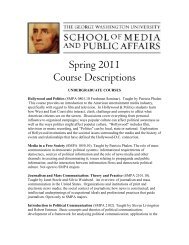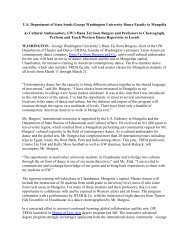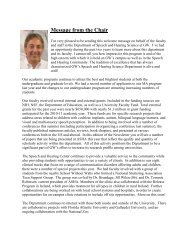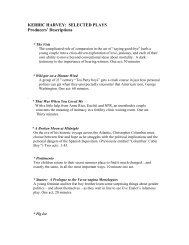Columbian College of Arts and Sciences - The George Washington ...
Columbian College of Arts and Sciences - The George Washington ...
Columbian College of Arts and Sciences - The George Washington ...
You also want an ePaper? Increase the reach of your titles
YUMPU automatically turns print PDFs into web optimized ePapers that Google loves.
Spotlight on Faculty Research: Tales <strong>of</strong> Reading, Writing, & Publishing<br />
Slumming: Sexual <strong>and</strong> Racial Encounters in<br />
American Nightlife, 1885-1940<br />
by Chad Heap<br />
University <strong>of</strong> Chicago Press, 2009<br />
When I first began work on<br />
Slumming, I saw the project<br />
primarily as a contribution to<br />
the history <strong>of</strong> sexuality.<br />
Building on exemplary<br />
scholarship that plumbed the<br />
complicated interrelation <strong>of</strong><br />
sexuality, gender, <strong>and</strong> class, I<br />
hoped to examine more<br />
systematically how race had<br />
shaped American sexual<br />
identities <strong>and</strong> practices. But as I<br />
charted the historical<br />
progression <strong>of</strong> slumming from<br />
the immigrant <strong>and</strong> working-class districts <strong>of</strong> turn-<strong>of</strong>-thecentury<br />
New York <strong>and</strong> Chicago to those cities’ later freeloving<br />
bohemian districts, bustling black neighborhoods, <strong>and</strong><br />
early lesbian <strong>and</strong> gay enclaves, I realized my project was as<br />
much about the history <strong>of</strong> racial formation <strong>and</strong> the<br />
reorganization <strong>of</strong> urban space as it was about sexuality.<br />
While scholars have long investigated the social<br />
construction <strong>of</strong> race <strong>and</strong> sexuality in the United States,<br />
surprisingly few have attempted to examine the ways in which<br />
popular conceptions <strong>of</strong> racial <strong>and</strong> sexual difference took shape<br />
in relation to each other. In Slumming, I seek to address this<br />
oversight by demonstrating how race <strong>and</strong> sexuality became<br />
intertwined in this unusual urban pastime, <strong>and</strong> by showing<br />
how the pastime itself contributed significantly to the<br />
emergence <strong>and</strong> codification <strong>of</strong> a new twentieth-century<br />
hegemonic social order—one that was structured primarily<br />
around an increasingly polarized white/black racial axis <strong>and</strong> a<br />
hetero/homo sexual binary that were defined in reciprocal<br />
relationship to one another.<br />
In addition, I examine how slumming transformed<br />
Americans’ underst<strong>and</strong>ing <strong>of</strong> urban space. As the pastime<br />
came to focus less on the geographic space <strong>of</strong> the slum itself<br />
<strong>and</strong> more on the amusement <strong>of</strong> slumming, it encouraged<br />
participants to view the new urban districts <strong>and</strong> populations<br />
they visited in terms <strong>of</strong> the slum <strong>and</strong>, thereby, reinforced white<br />
Americans’ sense <strong>of</strong> superiority by associating racial <strong>and</strong> sexual<br />
difference with dilapidation <strong>and</strong> immorality.<br />
Since similar processes are underway in today’s gentrifying<br />
cities, I hope readers <strong>of</strong> Slumming will give as much thought to<br />
their own interconnected perceptions <strong>of</strong> race, sexuality, <strong>and</strong><br />
urban space, as they will to the historical processes my book<br />
describes.<br />
See also, <strong>The</strong> New Yorker for a review <strong>of</strong> Pr<strong>of</strong>. Heap’s book, at<br />
http://www.newyorker.com/arts/reviews/brieflynoted/2009/<br />
06/29/090629crbn_brieflynoted2<br />
Acts <strong>of</strong> Conscience: Christian Nonviolence <strong>and</strong><br />
American Democracy<br />
by Joseph Kip Kosek<br />
Columbia University Press, 2009<br />
When considering the history<br />
<strong>of</strong> radical pacifism in the United<br />
States, perhaps the first<br />
question to ask is “What’s the<br />
point?” Why write about a<br />
belief system that apparently<br />
has become so marginal, so<br />
irrelevant, so invisible? We may<br />
oppose this or that war, but<br />
who can really embrace<br />
pacifism when confronted with<br />
such notorious figures as Adolf<br />
Hitler or Osama bin Laden?<br />
And yet, in the course <strong>of</strong><br />
researching Acts <strong>of</strong> Conscience, I found that radical pacifists had<br />
actually turned these questions around: How can we not<br />
address violence when violence was at the heart <strong>of</strong> virtually<br />
every major crisis <strong>of</strong> the 20 th century? Indeed, historians state<br />
that, in this catastrophic hundred-year period, an estimated<br />
200 million people were killed by some form <strong>of</strong> organized<br />
slaughter. Hence, radical pacifists insisted that countering this<br />
epidemic <strong>of</strong> violence was the most urgent modern project, a<br />
project that non-pacifists (myself included) have ignored all<br />
too frequently.<br />
<strong>The</strong> pacifist tradition is especially relevant in our own<br />
time, when political decision makers assume that a position <strong>of</strong><br />
nonviolence is quaint, naïve, or an affectation <strong>of</strong> “<strong>The</strong> Sixties.”<br />
Acts <strong>of</strong> Conscience puts nonviolence back into its historical<br />
context as a sophisticated response to the overwhelming crises<br />
<strong>of</strong> the 20 th century. In the face <strong>of</strong> these events, radical pacifists<br />
undertook dramatic individual acts that achieved surprising<br />
political <strong>and</strong> cultural power. <strong>The</strong> cover depicts the “Union<br />
Eight,” a group <strong>of</strong> seminary students who were imprisoned<br />
after refusing to register for the World War II draft. <strong>The</strong>ir<br />
audacity provoked controversy then <strong>and</strong> now: Were they<br />
heroic? foolish? or dangerously wrong-headed? Whatever we<br />
think, these were not otherworldly saints holding olive<br />
branches, but worldly people grappling with moral<br />
responsibility amid unprecedented global calamity.<br />
A few years ago I met with one <strong>of</strong> the Union Eight,<br />
<strong>George</strong> Houser (third from the right on the book jacket). In<br />
the early civil rights movement, Houser led protests <strong>and</strong> had a<br />
major role in promoting anti-apartheid <strong>and</strong> independence<br />
movements in Africa. Now in his nineties, he still lives with<br />
his wife Jean in a small house they built after World War II in<br />
an interracial pacifist community outside <strong>of</strong> New York City.<br />
When I visited him, he told me he attends a small weekly vigil<br />
on a nearby street corner to protest the war in Iraq. Nearly<br />
seven decades after his shocking st<strong>and</strong> for nonviolence,<br />
<strong>George</strong> Houser is still putting conscience into action.<br />
Faculty Research—continued on next page<br />
American Studies 2008-09 14



